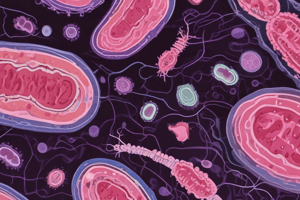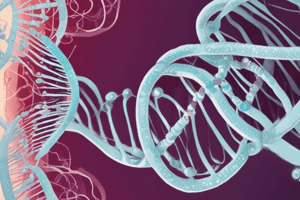Podcast
Questions and Answers
What are the two most important E.coli pathogroup in ruminants (ie Calves and lambs)
What are the two most important E.coli pathogroup in ruminants (ie Calves and lambs)
Neonatal diarrhea and neonatal diarrhea with septicemia
What adhesin receptors and toxins are associated with neonatal diarrhea?
What adhesin receptors and toxins are associated with neonatal diarrhea?
F5, F41; STa and EAST 1
The pathogroup : neonatal diarrhea and septicemia is more common than the pathogroup neonatal diarrhea
The pathogroup : neonatal diarrhea and septicemia is more common than the pathogroup neonatal diarrhea
False (B)
What is the primary factor determining whether an animal develops ETEC-related diarrhea?
What is the primary factor determining whether an animal develops ETEC-related diarrhea?
In the context of ETEC infections in calves and lambs, what does 'too little, too late, or too low' refer to?
In the context of ETEC infections in calves and lambs, what does 'too little, too late, or too low' refer to?
Which of the following best describes the typical onset of neonatal diarrhea due to E. coli in calves and lambs?
Which of the following best describes the typical onset of neonatal diarrhea due to E. coli in calves and lambs?
What is a characteristic feature of the feces associated with E. coli induced neonatal diarrhea?
What is a characteristic feature of the feces associated with E. coli induced neonatal diarrhea?
What is a common pathological change seen in calves and lambs after developing diarrhea from E.coli pathogroup Neonatal Diarrhea?
What is a common pathological change seen in calves and lambs after developing diarrhea from E.coli pathogroup Neonatal Diarrhea?
Which of the following adhesion(s) are noted in neonatal diarrhea? Select all that apply
Which of the following adhesion(s) are noted in neonatal diarrhea? Select all that apply
Lambs share the same clinical signs and pathogenesis with calves, the only difference is that they aren’t associated with F5, as F5 is in lambs only, while F41 is present in calves and lambs
Lambs share the same clinical signs and pathogenesis with calves, the only difference is that they aren’t associated with F5, as F5 is in lambs only, while F41 is present in calves and lambs
Which adhesin contributes to neonatal diarrhea and septicemia in calves/lambs?
Which adhesin contributes to neonatal diarrhea and septicemia in calves/lambs?
Which age group of calves is most susceptible to F17+ E. coli infections?
Which age group of calves is most susceptible to F17+ E. coli infections?
What is the most critical component of therapy for animals in shock due to E. coli infection?
What is the most critical component of therapy for animals in shock due to E. coli infection?
Why is antibiotic therapy considered controversial in the treatment of E. coli infections?
Why is antibiotic therapy considered controversial in the treatment of E. coli infections?
What is the primary goal of prevention strategies for E. coli infections in neonatal animals?
What is the primary goal of prevention strategies for E. coli infections in neonatal animals?
Flashcards
Neonatal diarrhea
Neonatal diarrhea
The most common E. coli pathogroup in young ruminants (like calves and lambs) that causes diarrhea without affecting the bloodstream.
Neonatal diarrhea with septicemia
Neonatal diarrhea with septicemia
The E. coli pathogroup in young ruminants (like calves and lambs) that causes diarrhea and can also lead to a dangerous blood infection (septicemia).
Neonatal diarrhea is more common than neonatal diarrhea with septicemia
Neonatal diarrhea is more common than neonatal diarrhea with septicemia
The E. coli type that causes diarrhea with septicemia is actually less common than the one that causes only diarrhea.
Immune System vs. Infection Pressure
Immune System vs. Infection Pressure
Signup and view all the flashcards
Colostrum: Insufficient, Delayed, or Low Antibodies
Colostrum: Insufficient, Delayed, or Low Antibodies
Signup and view all the flashcards
Too Early, Too High Infection Pressure
Too Early, Too High Infection Pressure
Signup and view all the flashcards
Neonatal Diarrhea (E. coli Pathogroup)
Neonatal Diarrhea (E. coli Pathogroup)
Signup and view all the flashcards
Neonatal Diarrhea: Symptoms
Neonatal Diarrhea: Symptoms
Signup and view all the flashcards
Study Notes
Pathogenesis of ETEC in Calves and Lambs
- Equilibrium between immunity and infection pressure influences ETEC development.
- Insufficient or delayed colostrum intake (low antibody levels) increases susceptibility.
- Early, high-pressure infections contribute to disease.
E. Coli Pathogroup (Neonatal Diarrhea)
- Diarrhea typically appears in the first week of life.
- Fecal consistency varies from pasty to watery, with a foul odor.
- Color ranges from pale yellow-white to occasionally containing flecks of blood.
- Significant fluid loss leads to rapid weight loss (within 6-8 hours).
- Histological examination of the intestinal mucosa usually shows no abnormalities.
Studying That Suits You
Use AI to generate personalized quizzes and flashcards to suit your learning preferences.



